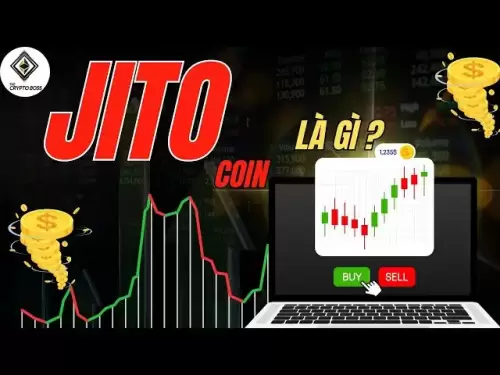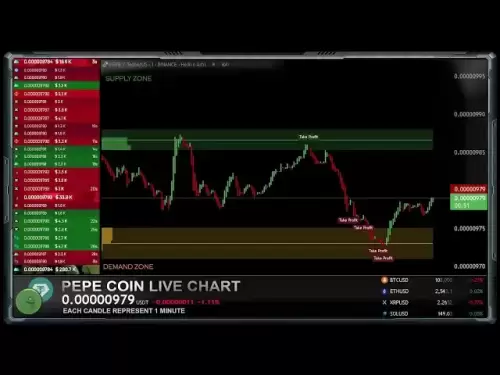-
 Bitcoin
Bitcoin $107,810.8710
-1.45% -
 Ethereum
Ethereum $2,531.4386
-1.75% -
 Tether USDt
Tether USDt $1.0000
-0.03% -
 XRP
XRP $2.2542
-0.99% -
 BNB
BNB $659.1350
-0.50% -
 Solana
Solana $148.5456
-2.40% -
 USDC
USDC $0.9999
-0.02% -
 TRON
TRON $0.2868
-0.44% -
 Dogecoin
Dogecoin $0.1666
-3.65% -
 Cardano
Cardano $0.5751
-2.36% -
 Hyperliquid
Hyperliquid $37.6845
-5.51% -
 Bitcoin Cash
Bitcoin Cash $494.9448
-0.65% -
 Sui
Sui $2.8396
-3.31% -
 Chainlink
Chainlink $13.2423
-2.59% -
 UNUS SED LEO
UNUS SED LEO $9.0482
0.02% -
 Stellar
Stellar $0.2467
-2.44% -
 Avalanche
Avalanche $17.8165
-3.63% -
 Shiba Inu
Shiba Inu $0.0...01158
-2.41% -
 Toncoin
Toncoin $2.7397
-3.42% -
 Hedera
Hedera $0.1560
-2.73% -
 Litecoin
Litecoin $85.8559
-2.34% -
 Monero
Monero $315.3710
-2.30% -
 Dai
Dai $1.0001
0.00% -
 Polkadot
Polkadot $3.3443
-2.03% -
 Ethena USDe
Ethena USDe $1.0001
0.01% -
 Bitget Token
Bitget Token $4.2888
-3.73% -
 Uniswap
Uniswap $7.3388
-1.57% -
 Aave
Aave $278.2986
-3.05% -
 Pepe
Pepe $0.0...09807
-3.67% -
 Pi
Pi $0.4563
-2.39%
Under what circumstances will bitcoin contract leverage trade explode?
Leverage trade explosions in Bitcoin occur when rapid price downturns, high leverage, and extreme volatility combine to trigger margin calls and subsequent liquidations.
Nov 14, 2024 at 10:08 am

Understanding the Potential Triggers for Bitcoin Contract Leverage Trade Explosions
Step 1: What is Bitcoin Contract Leverage Trade?
- An introduction to Bitcoin contract leverage trading, a popular trading strategy involving the use of borrowed capital to amplify potential profits.
- Leveraged trading in cryptocurrency markets carries significant risks, making it crucial to understand the underlying principles.
Step 2: When Does Bitcoin Contract Leverage Trade Explode?
- Leverage trade explosions occur when the underlying asset price undergoes a sudden and significant decline, resulting in a margin call and subsequent liquidation of the leveraged position.
These explosions can be triggered by various factors, including:
- Rapid market downturns: A sharp drop in Bitcoin's price can trigger margin calls and liquidations, leading to exponential losses.
- High leverage: Excessive leverage amplifies both profits and losses, increasing the vulnerability to price fluctuations.
- Large market volatility: Extreme volatility in Bitcoin's price creates uncertainty and increases the likelihood of sudden price movements.
Step 3: Risk Management for Leverage Trading
Implementing solid risk management strategies is paramount to mitigate the risk of leverage trade explosions. Key strategies include:
- Proper leverage selection: Determine an appropriate leverage ratio based on risk tolerance and market conditions.
- Stop-loss orders: Set automated orders to close positions at predefined price levels to limit potential losses.
- Position sizing: Calculate an optimal position size to align with risk appetite and account balance.
Step 4: Leveraged Trading Platforms
Choosing a reputable leveraged trading platform is crucial for security, liquidity, and favorable trading conditions:
- Binance: Largest cryptocurrency exchange by trading volume, offering multiple trading pairs and advanced trading tools.
- Huobi: Global exchange recognized for its advanced order types and deep liquidity.
- KuCoin: Platform known for its wide selection of altcoins and user-friendly interface.
- Kraken: Exchange with a strong reputation for security and compliance, offering futures and margin trading services.
Step 5: Understanding Margin Call and Liquidation
- Margin call: Occurs when a trader's account balance falls below the required margin level due to unfavorable price movements.
- Liquidation: Automatic closure of a leverage trade position to recover losses incurred by the broker.
Step 6: Avoiding Leveraged Trading Explosions
Prudent steps to prevent leverage trade implosions:
- Market analysis and risk assessment: Conduct thorough market analysis and understand potential risks before initiating leveraged trades.
- Emotional control: Avoid making decisions based on emotions or impulses, which can lead to unnecessary risks.
- Scenario planning: Simulate potential market scenarios and devise appropriate trading strategies to manage risk effectively.
Disclaimer:info@kdj.com
The information provided is not trading advice. kdj.com does not assume any responsibility for any investments made based on the information provided in this article. Cryptocurrencies are highly volatile and it is highly recommended that you invest with caution after thorough research!
If you believe that the content used on this website infringes your copyright, please contact us immediately (info@kdj.com) and we will delete it promptly.
- Pump.fun's PUMP Token and Gate.io: A $4 Billion Meme Coin Gamble?
- 2025-07-08 16:30:12
- DigitalX, BTC Holdings, Funding Secured: Aussie Crypto Firm Goes Big on Bitcoin
- 2025-07-08 17:10:12
- Acquire.Fi: Navigating the Web3 M&A Landscape as a Consultant
- 2025-07-08 16:30:12
- Bitcoin ETFs, Inflows, and Selling Pressure: A Tug-of-War in the Crypto Market
- 2025-07-08 17:50:12
- Chainlink (LINK) Price Analysis: Navigating Uncertainty with Analysts' Insights
- 2025-07-08 16:50:12
- Murano, Bitcoin, and Treasury Strategy: A New Era for Real Estate?
- 2025-07-08 17:50:12
Related knowledge

How to identify the contract value range in combination with the market profile?
Jul 02,2025 at 10:56pm
Understanding the Market ProfileTo effectively identify the contract value range in combination with the market profile, it's essential to first understand what each concept entails. The market profile is a framework that helps traders visualize how price and time interact across a given period, typically a trading day or session. It provides insights i...

How to use the price slope to filter the false breakthrough signal of the contract?
Jun 20,2025 at 06:56pm
Understanding the Concept of Price Slope in Contract TradingIn contract trading, especially within cryptocurrency derivatives markets, price slope refers to the rate at which the price changes over a specific time period. It helps traders assess the strength and sustainability of a trend. A steep slope may indicate strong momentum, while a shallow slope...

How to determine the expected volatility of the contract through the volatility cone?
Jun 19,2025 at 12:28pm
Understanding the Basics of Volatility in Cryptocurrency ContractsIn the realm of cryptocurrency trading, volatility is a key metric that traders use to assess potential risk and reward. When dealing with futures contracts, understanding how volatile an asset might become over time is crucial for position sizing, risk management, and strategy developmen...

How to formulate a contract intraday trading plan in combination with the pivot point system?
Jun 21,2025 at 03:42pm
Understanding the Basics of Pivot Points in Cryptocurrency TradingPivot points are technical analysis tools used by traders to identify potential support and resistance levels. These levels are calculated using the previous day's high, low, and closing prices. In the context of cryptocurrency trading, where markets operate 24/7, pivot points help trader...

How to adjust the contract position ratio through the price fluctuation entropy?
Jun 22,2025 at 11:42am
Understanding Price Fluctuation Entropy in Cryptocurrency ContractsIn the world of cryptocurrency futures trading, price fluctuation entropy is a relatively new concept used to measure market volatility and uncertainty. It derives from information theory, where entropy refers to the degree of randomness or unpredictability in a system. In crypto contrac...

How to use the volume swing indicator to predict the contract volume-price divergence?
Jun 18,2025 at 11:42pm
Understanding the Volume Swing IndicatorThe volume swing indicator is a technical analysis tool used primarily in cryptocurrency trading to evaluate changes in volume over time. Unlike price-based indicators, this metric focuses solely on trading volume, which can provide early signals about potential market reversals or continuations. The key idea behi...

How to identify the contract value range in combination with the market profile?
Jul 02,2025 at 10:56pm
Understanding the Market ProfileTo effectively identify the contract value range in combination with the market profile, it's essential to first understand what each concept entails. The market profile is a framework that helps traders visualize how price and time interact across a given period, typically a trading day or session. It provides insights i...

How to use the price slope to filter the false breakthrough signal of the contract?
Jun 20,2025 at 06:56pm
Understanding the Concept of Price Slope in Contract TradingIn contract trading, especially within cryptocurrency derivatives markets, price slope refers to the rate at which the price changes over a specific time period. It helps traders assess the strength and sustainability of a trend. A steep slope may indicate strong momentum, while a shallow slope...

How to determine the expected volatility of the contract through the volatility cone?
Jun 19,2025 at 12:28pm
Understanding the Basics of Volatility in Cryptocurrency ContractsIn the realm of cryptocurrency trading, volatility is a key metric that traders use to assess potential risk and reward. When dealing with futures contracts, understanding how volatile an asset might become over time is crucial for position sizing, risk management, and strategy developmen...

How to formulate a contract intraday trading plan in combination with the pivot point system?
Jun 21,2025 at 03:42pm
Understanding the Basics of Pivot Points in Cryptocurrency TradingPivot points are technical analysis tools used by traders to identify potential support and resistance levels. These levels are calculated using the previous day's high, low, and closing prices. In the context of cryptocurrency trading, where markets operate 24/7, pivot points help trader...

How to adjust the contract position ratio through the price fluctuation entropy?
Jun 22,2025 at 11:42am
Understanding Price Fluctuation Entropy in Cryptocurrency ContractsIn the world of cryptocurrency futures trading, price fluctuation entropy is a relatively new concept used to measure market volatility and uncertainty. It derives from information theory, where entropy refers to the degree of randomness or unpredictability in a system. In crypto contrac...

How to use the volume swing indicator to predict the contract volume-price divergence?
Jun 18,2025 at 11:42pm
Understanding the Volume Swing IndicatorThe volume swing indicator is a technical analysis tool used primarily in cryptocurrency trading to evaluate changes in volume over time. Unlike price-based indicators, this metric focuses solely on trading volume, which can provide early signals about potential market reversals or continuations. The key idea behi...
See all articles

























































































